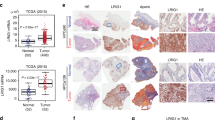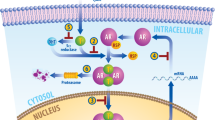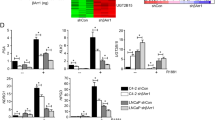Abstract
Altered androgen-receptor (AR) expression and/or constitutively active AR are commonly associated with prostate cancer (PCa) progression. Targeting AR remains a focal point for designing new strategy of PCa therapy. Here, we have shown that DAB2IP, a novel tumor suppressor in PCa, can inhibit AR-mediated cell growth and gene activation in PCa cells via distinct mechanisms. DAB2IP inhibits the genomic pathway by preventing AR nuclear translocation or phosphorylation and suppresses the non-genomic pathway via its unique functional domain to inactivate c-Src. Also, DAB2IP is capable of suppressing AR activation in an androgen-independent manner. In addition, DAB2IP can inhibit several AR splice variants showing constitutive activity in PCa cells. In DAB2IP−/− mice, the prostate gland exhibits hyperplastic epithelia, in which AR becomes more active. Consistently, DAB2IP expression inversely correlates with AR activation status particularly in recurrent or metastatic PCa patients. Taken together, DAB2IP is a unique intrinsic AR modulator in normal cells, and likely can be further developed into a therapeutic agent for PCa.
This is a preview of subscription content, access via your institution
Access options
Subscribe to this journal
Receive 50 print issues and online access
$259.00 per year
only $5.18 per issue
Buy this article
- Purchase on Springer Link
- Instant access to full article PDF
Prices may be subject to local taxes which are calculated during checkout







Similar content being viewed by others
References
Huggins C, Hodges CV . Studies on prostatic cancer I. The effect of castration, of estrogen and of androgen injection on serum phosphatases in metastatic carcinoma of the prostate (Reprinted from Cancer Res, vol 1, pg 293-297, 1941). J Urol 2002; 167: 948–951.
Heinlein CA, Chang CS . Androgen receptor in prostate cancer. Endocr Rev 2004; 25: 276–308.
Feldman BJ, Feldman D . The development of androgen-independent prostate cancer. Nat Rev Cancer 2001; 1: 34–45.
Visakorpi T, Hyytinen E, Koivisto P, Tanner M, Keinanen R, Palmberg C et al. In vivo amplification of the androgen receptor gene and progression of human prostate cancer. Nat Genet 1995; 9: 401–406.
McKenna NJ, Lanz RB, O'Malley BW . Nuclear receptor coregulators: Cellular and molecular biology. Endocr Rev 1999; 20: 321–344.
Brooke GN, Bevan CL . The role of androgen receptor mutations in prostate cancer progression. Curr Genomics 2009; 10: 18–25.
Watson PA, Chen YNF, Balbas MD, Wongvipat J, Socci ND, Viale A et al. Constitutively active androgen receptor splice variants expressed in castration-resistant prostate cancer require full-length androgen receptor. Proc Natl Acad Sci USA 2010; 107: 16759–16765.
Guo ZY, Yang X, Sun F, Jiang RC, Linn DE, Chen HG et al. A novel androgen receptor splice variant is up-regulated during prostate cancer progression and promotes androgen depletion-resistant growth. Cancer Res 2009; 69: 2305–2313.
Sun SH, Sprenger CCT, Vessella RL, Haugk K, Soriano K, Mostaghel EA et al. Castration resistance in human prostate cancer is conferred by a frequently occurring androgen receptor splice variant. J Clin Invest 2010; 120: 2715–2730.
Shang YF, Myers M, Brown M . Formation of the androgen receptor transcription complex. Mol Cell 2002; 9: 601–610.
Wang QB, Li W, Liu XS, Carroll JS, Janne OA, Keeton EK et al. A hierarchical network of transcription factors governs androgen receptor-dependent prostate cancer growth. Mol Cell 2007; 27: 380–392.
Wang QB, Carroll JS, Brown M . Spatial and temporal recruitment of androgen receptor and its coactivators involves chromosomal looping and polymerase tracking. Mol Cell 2005; 19: 631–642.
Wen Y, Hu MCT, Makino K, Spohn B, Bartholomeusz G, Yan DH et al. HER-2/neu promotes androgen-independent survival and growth of prostate cancer cells through the Akt pathway. Cancer Res 2000; 60: 6841–6845.
Craft N, Shostak Y, Carey M, Sawyers CL . A mechanism for hormone-independent prostate cancer through modulation of androgen receptor signaling by the HER-2/neu tyrosine kinase. Nat Med 1999; 5: 280–285.
Wang Z, Tseng CP, Pong RC, Chen H, McConnell JD, Navone N et al. The mechanism of growth-inhibitory effect of DOC-2/DAB2 in prostate cancer — characterization of a novel GTPase-activating protein associated with N-terminal domain of DOC-2/DAB2. J Biol Chem 2002; 277: 12622–12631.
Xie DX, Gore C, Zhou J, Pong RC, Zhang HF, Yu LY et al. DAB2IP coordinates both PI3K-Akt and ASK1 pathways for cell survival and apoptosis. Proc Natl Acad Sci USA 2009; 106: 19878–19883.
Chen H, Toyooka S, Gazdar AF, Hsieh JT . Epigenetic regulation of a novel tumor suppressor gene (hDAB2IP) in prostate cancer cell lines. J Biol Chem 2003; 278: 3121–3130.
Chen H, Tu SW, Hsieh JT . Down-regulation of human DAB2IP gene expression mediated by polycomb Ezh2 complex and histone deacetylase in prostate cancer. J Biol Chem 2005; 280: 22437–22444.
Yano M, Toyooka S, Tsukuda K, Dote H, Ouchida M, Hanabata T et al. Aberrant promoter methylation of human DAB2 interactive protein (hDAB2IP) gene in lung cancers. Int J Cancer 2005; 113: 59–66.
Dote H, Toyooka S, Tsukuda K, Yano M, Ota T, Murakami M et al. Aberrant promoter methylation in human DAB2 interactive protein (hDAB2IP) gene in gastrointestinal tumour. Br J Cancer 2005; 92: 1117–1125.
Dote H, Toyooka S, Tsukuda K, Yano M, Ouchida M, Doihara H et al. Aberrant promoter methylation in human DAB2 interactive protein (hDAB2IP) gene in breast cancer. Clin Cancer Res 2004; 10: 2082–2089.
Qiu GH, Xie HM, Wheelhouse N, Harrison D, Chen GG, Salto-Tellez M et al. Differential expression of hDAB2IPA and hDAB2IPB in normal tissues and promoter methylation of hDAB2IPA in hepatocellular carcinoma. J Hepatol 2007; 46: 655–663.
Xie DX, Gore C, Liu J, Pong RC, Mason R, Hao GY et al. Role of DAB2IP in modulating epithelial-to-mesenchymal transition and prostate cancer metastasis. Proc Natl Acad Sci USA 2010; 107: 2485–2490.
Min J, Zaslavsky A, Fedele G, McLaughlin SK, Reczek EE, De Raedt T et al. An oncogene-tumor suppressor cascade drives metastatic prostate cancer by coordinately activating Ras and nuclear factor-kappa B. Nat Med 2010; 16: 286–U282.
Gioeli D, Black BE, Gordon V, Spencer A, Kesler CT, Eblen ST et al. Stress kinase signaling regulates androgen receptor phosphorylation, transcription, and localization. Mol Endocrinol 2006; 20: 503–515.
Kesler CT, Gioeli D, Conaway MR, Weber MJ, Paschal BM . Subcellular localization modulates activation function 1 domain phosphorylation in the androgen receptor. Mol Endocrinol 2007; 21: 2071–2084.
Chen S, Gulla S, Cai C, Balk SP . Androgen receptor serine 81 phosphorylation mediates chromatin binding and transcriptional activation. J Biol Chem 2012; 287: 8571–8583.
Gordon V, Bhadel S, Wunderlich W, Zhang J, Ficarro SB, Mollah SA et al. CDK9 regulates AR promoter selectivity and cell growth through serine 81 phosphorylation. Mol Endocrinol 2010; 24: 2267–2280.
Min W, Lin Y, Tang SB, Yu LY, Zhang HF, Wan T et al. AIP1 recruits phosphatase PP2A to ASK1 in tumor necrosis factor-induced ASK1-JNK activation. Circ Res 2008; 102: 840–848.
Yang CS, Vitto MJ, Busby SA, Garcia BA, Kesler CT, Gioeli D et al. Simian virus 40 small t antigen mediates conformation-dependent transfer of protein phosphatase 2A onto the androgen receptor. Mol Cell Biol 2005; 25: 1298–1308.
Verras M, Brown J, Li XM, Nusse R, Sun ZJ . Wnt3a growth factor induces androgen receptor-mediated transcription and enhances cell growth in human prostate cancer cells. Cancer Res 2004; 64: 8860–8866.
Hu R, Dunn TA, Wei S, Isharwal S, Veltri RW, Humphreys E et al. Ligand-independent androgen receptor variants derived from splicing of cryptic exons signify hormone-refractory prostate cancer. Cancer Res 2009; 69: 16–22.
Guo Z, Yang X, Sun F, Jiang R, Linn DE, Chen H et al. A novel androgen receptor splice variant is up-regulated during prostate cancer progression and promotes androgen depletion-resistant growth. Cancer Res 2009; 69: 2305–2313.
Cao WH, Luttrell LM, Medvedev AV, Pierce KL, Daniel KW, Dixon TM et al. Direct binding of activated c-Src to the beta(3)-adrenergic receptor is required for MAP kinase activation. J Biol Chem 2000; 275: 38131–38134.
Wright CD, Chen QH, Baye NL, Huang Y, Healy CL, Kasinathan S et al. Nuclear alpha 1-adrenergic receptors signal activated Erk localization to caveolae in adult cardiac myocytes. Circ Res 2008; 103: 992–1000.
Zhou XE, Suino-Powell KM, Li J, He YZ, MacKeigan JP, Melcher K et al. Identification of SRC3/AIB1 as a preferred coactivator for hormone-activated androgen receptor. J Biol Chem 2010; 285: 9161–9171.
Duggan D, Zheng SL, Knowlton M, Benitez D, Dimitrov L, Wiklund F et al. Two genome-wide association studies of aggressive prostate cancer implicate putative prostate tumor suppressor gene DAB21P. J Natl Cancer Inst 2007; 99: 1836–1844.
Debes JD, Tindall DJ . Mechanisms of androgen-refractory prostate cancer. N Engl J Med 2004; 351: 1488–1490.
Chen H, Toyooka S, Gazdar AF, Hsieh JT . Epigenetic regulation of a novel tumor suppressor gene (hDAB2IP) in prostate cancer cell lines. J Biol Chem 2003; 278: 3121–3130.
Chen H, Tu SW, Hsieh JT . Down-regulation of human DAB2IP gene expression mediated by polycomb Ezh2 complex and histone deacetylase in prostate cancer. J Biol Chem 2005; 280: 22437–22444.
Min J, Zaslavsky A, Fedele G, McLaughlin SK, Reczek EE, De Raedt T et al. An oncogene-tumor suppressor cascade drives metastatic prostate cancer by coordinately activating Ras and nuclear factor-kappaB. Nat Med 2010; 16: 286–294.
Vidal M, Gigoux V, Garbay C . SH2 and SH3 domains as targets for anti-proliferative agents. Crit Rev Oncol Hematol 2001; 40: 175–186.
Mayer BJ . SH3 domains: complexity in moderation. J Cell Sci 2001; 114: 1253–1263.
Yu EY, Wilding G, Posadas E, Gross M, Culine S, Massard C et al. Phase II study of dasatinib in patients with metastatic castration-resistant prostate cancer. Clin Cancer Res 2009; 15: 7421–7428.
Araujo JC, Mathew P, Armstrong AJ, Braud EL, Posadas E, Lonberg M et al. Dasatinib combined with docetaxel for castration-resistant prostate cancer: results from a phase 1-2 study. Cancer 2012; 118: 63–71.
Tatarov O, Mitchell TJ, Seywright M, Leung HY, Brunton VG, Edwards J . Src family kinase activity is up-regulated in hormone-refractory prostate cancer. Clin Cancer Res 2009; 15: 3540–3549.
Cai HJ, Babic I, Wei X, Huang JT, Witte ON . Invasive prostate carcinoma driven by c-Src and androgen receptor synergy. Cancer Res 2011; 71: 862–872.
Sun S, Sprenger CC, Vessella RL, Haugk K, Soriano K, Mostaghel EA et al. Castration resistance in human prostate cancer is conferred by a frequently occurring androgen receptor splice variant. J Clin Invest 2010; 120: 2715–2730.
Harvey JM, Clark GM, Osborne CK, Allred DC . Estrogen receptor status by immunohistochemistry is superior to the ligand-binding assay for predicting response to adjuvant endocrine therapy in breast cancer. J Clin Oncol 1999; 17: 1474–1481.
Acknowledgements
We thank Dr Jiang Min for editorial assistant and Rui Li for technical support. This work is supported in part by United States Army Grant W81XWH-04-1-0222 (JTH) and the National Natural Science Foundation of China (NSFC 81202014 to KW).
Author information
Authors and Affiliations
Corresponding authors
Ethics declarations
Competing interests
The authors declare no conflict of interest.
Additional information
Supplementary Information accompanies this paper on the Oncogene website
Supplementary information
Rights and permissions
About this article
Cite this article
Wu, K., Liu, J., Tseng, SF. et al. The role of DAB2IP in androgen receptor activation during prostate cancer progression. Oncogene 33, 1954–1963 (2014). https://doi.org/10.1038/onc.2013.143
Received:
Revised:
Accepted:
Published:
Issue Date:
DOI: https://doi.org/10.1038/onc.2013.143
Keywords
This article is cited by
-
Disabled-2, a versatile tissue matrix multifunctional scaffold protein with multifaceted signaling: Unveiling its potential in the cancer battle
Naunyn-Schmiedeberg's Archives of Pharmacology (2024)
-
Epigenetic Regulation in Prostate Cancer Progression
Current Molecular Biology Reports (2018)
-
Block one, unleash a hundred. Mechanisms of DAB2IP inactivation in cancer
Cell Death & Differentiation (2017)
-
RASAL2, a RAS GTPase-activating protein, inhibits stemness and epithelial–mesenchymal transition via MAPK/SOX2 pathway in bladder cancer
Cell Death & Disease (2017)
-
Roles of Distal and Genic Methylation in the Development of Prostate Tumorigenesis Revealed by Genome-wide DNA Methylation Analysis
Scientific Reports (2016)



